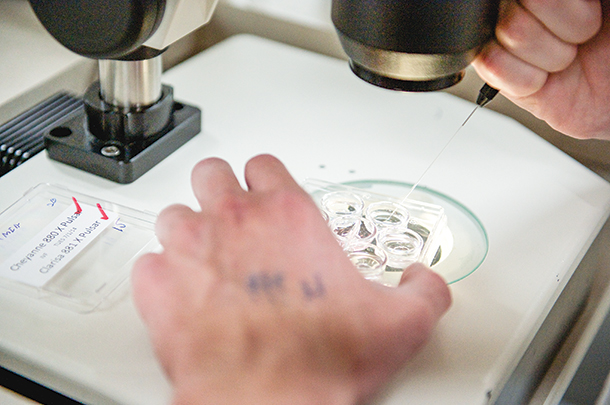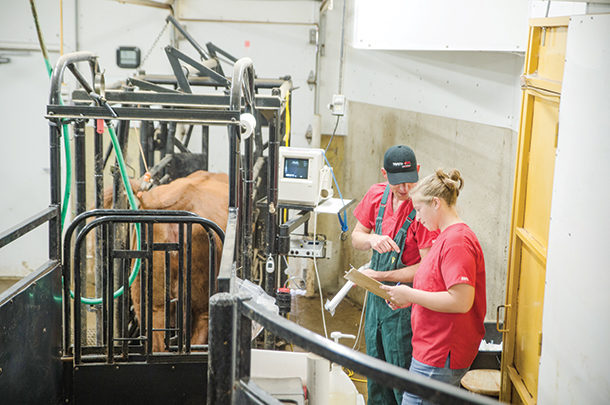IVF is technology that allows breeders who would like to get a jump on the next generation to do so without altering other vital aspects of their breeding program, when compared to conventional embryo transfer (ET). Usable embryo development rates at 30% every two weeks are comparable to conventional ET, and the IVF process can be more cost effective, making it a leading choice for the progressive producer to create the most value in his or her program. Embryo quality and recipient selection and management are key factors that dictate the success of an embryo transfer program utilizing in vitro-produced embryos.
IVF is the process of creating embryos from oocytes (unfertilized egg cells) by fertilizing them with semen in a petri dish. Oocytes are first collected from the ovaries of donors by ultrasound-guided follicular aspiration. They are then matured in specialized maturation media and fertilized 18 to 24 hours later. Conventional, sexed frozen, or reverse-sorted semen may be used for fertilization. Fertilized oocytes then develop in an incubator for seven days, at which point the resulting embryos are evaluated and frozen or transferred fresh into recipients.
During evaluation, stage of development and quality of the embryo are assessed. Quality of the embryo directly correlates with the grade it receives. The International Embryo Transfer Society has developed a standardized coding system for use in describing the quality of embryos. The codes for embryo quality are numerical and based on morphological integrity. Producers can expect their embryos to be coded on a scale of 1 to 4.
- Grade 1 embryos are deemed excellent or good and survive well during freezing and thawing. Grade 1 embryos are called “freezable embryos” and are also recommended for international trade.
- Grade 2 embryos are identified as fair. Although they are not as high quality as a Grade 1 embryos, they may undergo the freeze or thaw process and will produce satisfactory pregnancy results when transferred.
- Grade 3 embryos are designated as poor quality. These embryos do not survive the freezing or thawing procedure; however, they are eligible to be transferred fresh.
- Grade 4 embryos are considered dead or degenerating. They are nonviable embryos and should be discarded.
On average, 30% of the oocytes collected from a donor will develop into a viable embryo (Grade 1, 2 or 3). Typically, we expect to collect approximately 18 to 22 oocytes per aspiration; therefore, we anticipate about 5 to 6 transferrable embryos per IVF cycle, on average. Donors that produce greater numbers of oocytes and oocytes of higher quality may see a larger number of embryos produced, whereas donors with compromised reproductive conditions may have lower results. Development rate will also vary greatly depending on the sire used and semen type. On a given sire, the development rate between conventional and reverse-sorted semen is generally similar; however, a significant decrease in development rate may be seen with pre-sexed frozen semen.
A high-quality in vitro-produced embryo is more likely to create a pregnancy, but fair and poor-quality embryos have shown satisfactory pregnancy results when transferred. On average, fresh IVF embryos achieve about a 55% pregnancy rate, while pregnancy rates from frozen IVF embryos (Grade 1 or 2) average 45%-50%. These results will vary somewhat, depending on the time of year, type of recipient and recipient management.
 Before transfer into recipients, embryos are evaluated based on a standardized system developed by the International Embryo Transfer Society. Photo courtesy of Trans Ova.
Before transfer into recipients, embryos are evaluated based on a standardized system developed by the International Embryo Transfer Society. Photo courtesy of Trans Ova.Selection of recipients is one of the most important aspects of an embryo transfer program. It is imperative to have good-quality, well-managed recipients to have a successful program. When selecting recipients, take into consideration the following criteria:
1. Recipient cows 3 to 8 years old make ideal recipients, once they have a good calving record.
2. Cows must be reproductively sound in that they have a fully intact reproductive tract without adhesions of the uterine horns or ovaries.
3. The recipient cow should be fertile and free of a history of calving problems and free of issues conceiving to A.I. or natural breeding.
4. Utilize cows that are at least 60 days post-calving, ideally 75 days post-calving.
5. Remove any cows with temperament problems from the program.
6. Cows should be at a body condition score of at least 5 prior to implantation to achieve adequate success in conception.
Management of recipient cows is equally as important as the selection process. Work with a nutritionist to design a suitable nutrition plan for the recipient cattle. Recipients should be adapted to and kept on the same feeding program during the embryo transfer process, including synchronization, implantation and six to eight weeks post implantation. Administer or feed vitamin and mineral supplements at least four weeks prior to implanting.
Work with a veterinarian to discuss the best vaccination options for your recipient cattle. Consider reproductive/respiratory virals, such as infectious bovine rhinotracheitis (IBR), bovine viral diarrhea (BVD types 1 and 2), bovine respiratory syncytial virus (BRSV) and parainfluenza 3 (PI3); a five-way lepto; a seven-way clostridial; and a parasiticide in the vaccination process. Do not administer modified-live vaccines within 30 days of the target day of estrus.
Ensure that each recipient is clearly identified; tags must be easy to read and, whenever possible, placed in both ears. Finally, the optimal time for movement of recipients is one to two days after implantation. Movement between day 10 and 30 should be avoided, if possible. It is imperative to minimize the amount of environmental stress cows are exposed to.
Several factors contribute to a successful embryo transfer program utilizing in vitro-produced embryos. Embryo quality has a large impact on the success of the program. Usable embryo development rates at 30% every two weeks provides producers with the opportunity to produce, on average, 120 embryos per year, if 18 to 22 oocytes are collected from the donor per aspiration. This increases the likelihood for breeders to obtain more offspring from valuable females in their herd, shortening the generation interval. A solid selection process for embryo recipients and a steadfast management program will further increase the success of the embryo transfer program, ultimately improving the pregnancy rate and boosting the number of calves to hit the ground.









